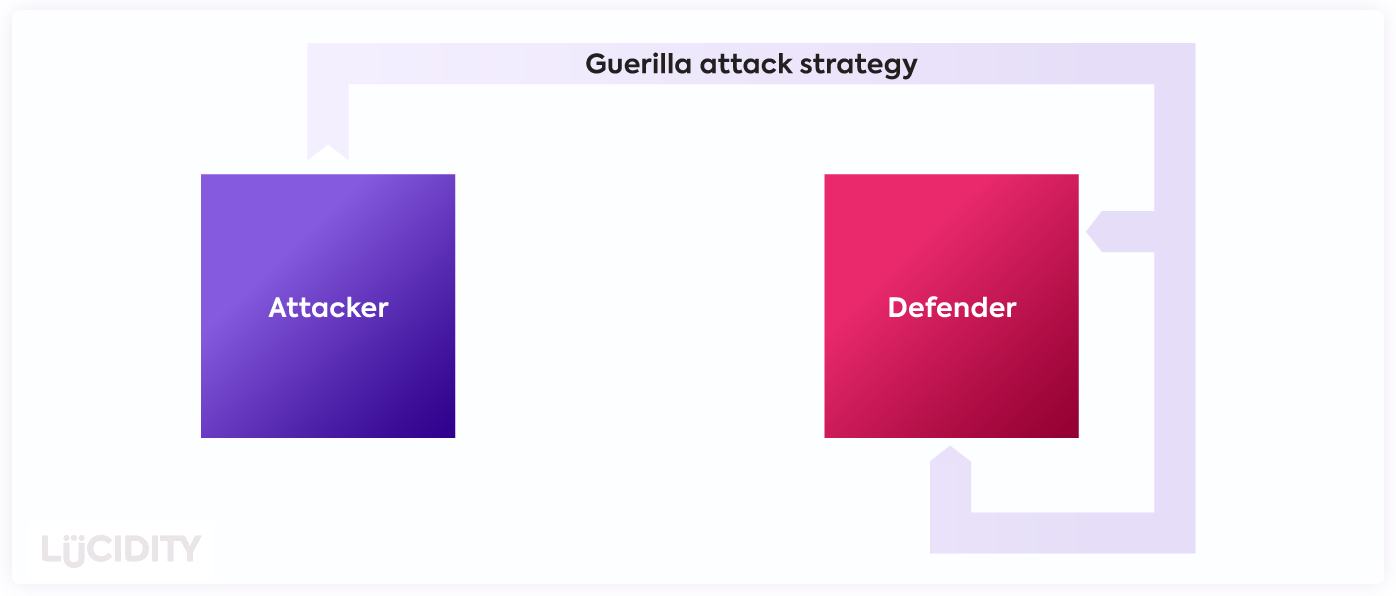Guerrilla warfare is a well-known term in the business world and relates to a particular way challenger companies attack their often-larger competitors to attract their customers and target audience. It can be quite an enjoyable way to take on larger players, so let’s learn more…
What is a Guerrilla Attack Strategy?
A Guerrilla Attack Strategy (also known as guerrilla marketing strategy) is where a series of small attacks are carried out against a company to dislodge it from a market position.
The objective of a Guerrilla Attack Strategy is to bombard, confuse and overwhelm the competitor with a relentless series of regular attacks. Small, ad hoc, marketing campaigns targeting your competitor’s activity. No discernible pattern to the attacks, no consistent approach – just opportunistic assaults that take the competitor by surprise and leave them struggling to react before the next attack is launched. This may also be referred to in some teams as ‘ambush marketing’.
The idea of a Guerrilla Attack Strategy is to sneak up on your competitor, give them a little poke, then appear from a different direction and poke again, then pop up somewhere else and keep nudging – ultimately leaving them in a spin as they try to react to your attacks whilst new ones are being fired at them.
![The Most Effective Guerrilla Attack Strategy Guide in 2022 2 [FREE GUIDE] The Ultimate Strategy Tips Collection](https://no-cache.hubspot.com/cta/default/5961834/d93580a0-3da4-4bc9-9e44-6aaccf0abbca.png)
What tactics are used in a Guerrilla Attack Strategy?
Good Guerrilla Marketing tactics are typically cost effective but require a great deal of creativity. The focus on less conventional tactics helps make a Guerrilla Attack harder to defend against. Not only does the frequency and volume of these smaller attacks make them challenging to react to, but the often-unexpected methods used adds another layer to the confusion and disorientation felt by the competitor being attacked.
Social media
A Guerrilla campaign will often utilise social media in a particularly creative way. Many Guerrilla marketers have used social to great effect with unconventional content that has ‘gone viral’. Although no marketer can guarantee their campaigns will go viral, working to create surprising, unconventional content that people will enjoy and share is a common technique used as part of a Guerrilla Attack.
Price promotions
Sharp, fast promotions are also a common technique used when launching a Guerrilla Attack Strategy. Heavy, short-term discounts or even giving products or services away for free for limited periods are tactics associated with this Attack Strategy. Making big splashes on social media about bold undercutting of prices is something you may have seen.
Stunts
Inventive ‘stunts’ are another technique used in Guerrilla Marketing. The idea here is to get people talking about your brand, create some buzz, and build a level of interest in your business that is hard for the market leading competitor (often a larger company) to authentically replicate and compete with. These Guerrilla ‘stunts’ are all about the element of surprise – extremely unconventional tactics that capture consumers’ attention. These are often live experiences that are then captured on video or in photos and shared and talked about on social media.
What these techniques have in common is that they are all relatively low-cost. Since a Guerilla Attack Strategy is focused on lots of small campaigns, each activity tends to be cheaper than traditional marketing tactics. For one thing, not all campaigns will succeed and have an impact on the competitor, so it’s important to try lots of ideas, without investing large sums and see what hits.
What tools and frameworks help in devising a Guerrilla Attack Strategy?
Before planning your Guerrilla Attack Strategy and deciding what tactics to employ, you need to understand you competitor in detail, and your own strengths and weaknesses, to ensure you know what activities will make the most impact and stand the best chances of being successful.
To that end, we’d recommend you do the following in advance of deploying your attacks:
- Develop a Four Corner Analysis to understand the strategy of your competitor
- Follow the competitor on LinkedIn, Facebook, Twitter and whatever other social networks they are active on as a lot of the attacks may be as a response to activity they’re conducting
- Understand what your own value is in the marketplace by looking at something like Value Chain Analysis
What are the advantages of a Guerrilla Attack Strategy?
The advantages of this strategy include:
- It’s fun, responsive and often can position your brand as the innovative, interesting challenger
- It’s hard to defend against as the attacks are frequent and ad hoc
- It can form part of a larger marketing strategy
- It’s relatively low cost to execute an individual attack
What are the disadvantages of a Guerrilla Attack Strategy?
There are some drawbacks to this strategy including:
- Attacks are small and so progress is often slow without a big win
- It requires constant innovation as each attack needs to be different with the next attack coming shortly after the last one
- Although low-cost for individual tactics, costs can start to rack up as you run multiple attacks over time
- It isn’t focused
- If done poorly the attacks can negatively impact your brand
![The Most Effective Guerrilla Attack Strategy Guide in 2022 2 [FREE GUIDE] The Ultimate Strategy Tips Collection](https://no-cache.hubspot.com/cta/default/5961834/d93580a0-3da4-4bc9-9e44-6aaccf0abbca.png)
What Guerrilla Marketing examples should you pay attention to?
Due to their unique and creative nature, strong Guerrilla Marketing ideas are often difficult to conceive, and arranging them into a marketing strategy can feel overwhelming.
For that reason, we have compiled a series of highly successful and inventive examples below to inspire you.
Our absolute favourite example of a Guerrilla Attack Strategy here at Lucidity, is by The Dollar Shave Club. This example really illustrates how fun Guerrilla Attacks can be to implement!
The Dollar Shave Club is a razor subscription business that ships razors to customers every month for $1. Obviously The Dollar Shave Club was taking on large, market-leading competitors like Gillette, and doing so as a small startup business. Not only was their subscription model completely new in the industry, but their Guerrilla marketing technique was unexpected, surprising and almost impossible to defend against for the large, established brands like Gillette.
At a relatively low cost, the guys at The Dollar Shave Club created a video. A video which is wonderfully funny and which openly mocks Gillette and similar high-end razor products. Check it out, it’s hilarious 👇
The video has had over 27 million views and on its launch, it generated so much interest for the business that the site crashed due to the volume of visitors. But this wasn’t just a funny video that happened to go viral, this was a great example of Guerrilla tactics well employed. The team at The Dollar Shave Club put an outreach campaign around the video, running a PR campaign that informed key online publications about the video, as well as paid social advertising to drive views.
Just a few years after the launch of this video and the business, Unilever acquired The Dollar Shave Club for $1 billion.
What are the alternatives to a Guerrilla Attack Strategy?
Guerrilla Marketing strategies are great. However, there are a few alternatives to them, and they are all slightly more consistent and coherent, so before you decide Guerrilla is the one for you, take a look at our guides below and ensure you’ve considered each approach to challenging a competitor…
Frontal Attack Strategy
This strategy is where you take the competition head on, matching their strength like for like. It’s a difficult one because the competitor is often strong.
Flanking Attack Strategy
This strategy is all about taking the competitor on in their weaker areas, the name stemming from when armies attacked in the middle under the assumption the front and back had the strongest stance.
Encirclement Attack Strategy
Encirclement involves attacking the competitor at all angles, this is expensive and resource intensive but effective at confusing the attacker.
Bypass Attack Strategy
Sometimes going round the competitor is the best approach. The Bypass strategy involves diversification into new markets or products/services that the competitor is not yet in or not strong in.
Whether you fancy yourself as a Guerrilla, and want to improve your Guerrilla Marketing campaigns, or end up opting for one of these alternatives, we wish you the best of luck in your battle with the competition.
Now map out your battle plan in Lucidity
Book a personal demo and we'll show you how simple it is to pull together your strategy plan with our easy-to-use tools.













